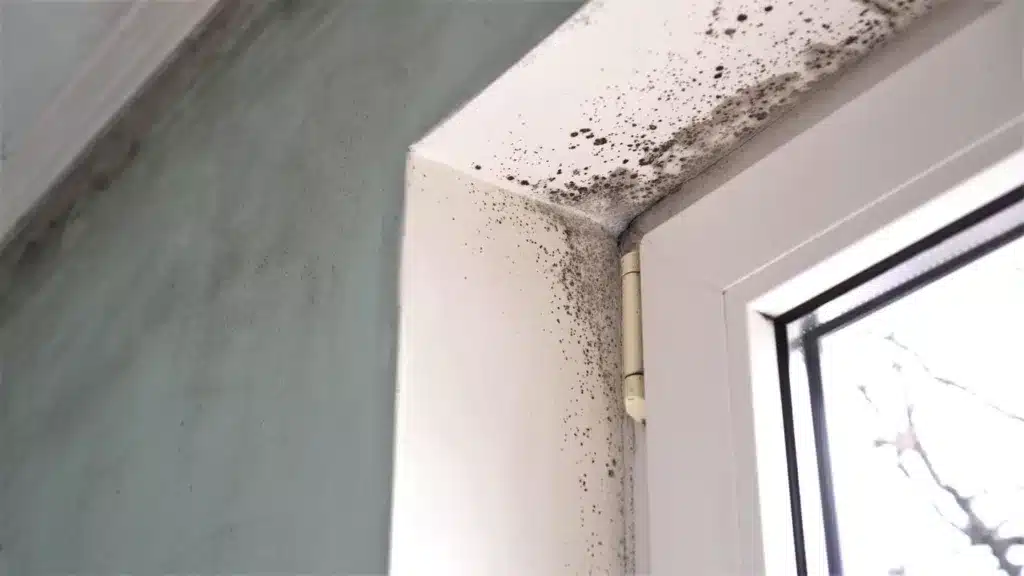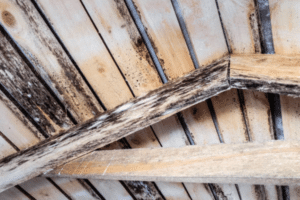Learning how to get rid of mould on windows can be a daunting task.
In fact, when it’s time to tackle this household issue, the main challenge for many is…
Understanding how to effectively remove mould from windows.
This knowledge separates those who live in a clean and healthy environment from those constantly battling with recurring mould issues. But if you don’t know how to eradicate window mould sustainably, you’ll never reach that level of comfort in your home.
Tackling window mould is no walk in the park.
Take for instance one of our customers who shared their story about trying numerous cleaning products without success… they ended up having an allergic reaction due to prolonged exposure to the stubborn spores!
The fear of dealing with such scenarios again has made them hesitant about tackling the problem head-on once more – not forgetting their worry about maintaining a safe living space free from allergens and irritants like black mould.
No wonder indeed!
But here’s some truth…
🚨 STOP: Do not attempt DIY mould removal if any of the following apply:
- Health issues caused by mould
- Mould area greater than 1 meter squared
- Recurring mould growth
- Mould in multiple areas
- Pregnant or have small children
- Respiratory issues like asthma
Mould can be extremely hazardous if improperly handled. If any of the above conditions apply to you, call our professional team immediately on 0203 130 4068 for safe, effective mould remediation. Don’t risk your health – we’ll take care of it!
Table of Contents:
- The Dangers of Black Mould on Windows
- Causes of Black Mould Growth on Windows
- How to Safely Remove Mould from Window Frames and Sills
- Preventing Future Mould Growth
- FAQs in Relation to How to Get Rid of Mould on Windows
- What are the best methods for removing mould from windows?
- How often should I clean my windows to prevent mould growth?
- Are there any special products or tools needed to remove mould from windows?
- Is it safe to use bleach on my windows when trying to get rid of mould?
- Can I use a pressure washer to remove mould from my windows?
- Conclusion
The Dangers of Black Mould on Windows
Black mould is more than just an unsightly nuisance.
It’s a silent predator, releasing harmful mycotoxins that can severely affect your health.
This toxic fungus thrives in damp environments and tends to form around windows and window sills where moisture levels are high. According to the NHS, black mould spores when inhaled or touched, can cause symptoms ranging from sneezing and skin rashes to chronic lung illnesses.
Babies, elderly people, those with pre-existing respiratory conditions – they’re all particularly vulnerable.
Read our article on ‘Understanding Black Mould Symptoms‘ to find out more about it’s health affects.
Dangerous Mycotoxins: The Hidden Threat
Mycotoxins are potent toxins released by certain types of mould including the notorious Stachybotrys chartarum or ‘black mould’ as its commonly known.
- Inhalation leads these invisible enemies straight into our airways causing inflammation and infection.
- Coming into contact with the skin may provoke allergic responses, including inflammation, irritation and even blistering.
- If ingested – though rare but possible through contaminated food – mycotoxins could harm internal organs like liver & kidneys.
Fighting Back Against Black Mould Exposure
Early detection followed by immediate action helps prevent long-term exposure effects.
In light of this information about black mould dangers lurking within our homes; especially near windows which provide perfect breeding grounds for them due its moist environment… let us now explore what causes their growth.
Causes of Black Mould Growth on Windows
Mould growth, particularly black mould, is a common issue that homeowners face.
This nuisance often forms around windows and window sills due to various reasons including leaking pipes, inadequate heating systems or poor roof repair.
Impact of Excess Moisture
The presence of excess moisture within the home environment can significantly contribute to mould development.
For instance, leaking pipes or inadequate heating systems can create moist conditions ideal for the proliferation of these harmful spores.
Role of Poor Ventilation
Poor ventilation exacerbates this problem by increasing humidity levels inside your house, making it crucial to improve air circulation in such cases.
- A simple yet effective way you can reduce condensation is through regular opening windows especially in areas prone to high moisture like bathrooms and kitchens.
Regardless if they are wooden or uPVC types, this happens when excessive amounts water seep into their structure causing them decay over time.
How to Safely Remove Mould from Window Frames and Sills
If you’ve noticed a mouldy area on your window frame or sill, it’s crucial to remove the mould promptly.
This not only enhances the aesthetic appeal of your windows but also prevents health hazards associated with inhaling harmful spores released by disturbed black mould.
If attempting DIY removal, strict safety measures are crucial
- Purchase an N95 respirator mask, goggles, gloves, and full sleeve protective clothing. Mould spores can irritate lungs and skin.
- Isolate the workspace by sealing vents, doors, windows with plastic sheeting. Use duct tape for a tight seal. This prevents spore spread.
- Place a box fan facing outwards in the window opening to ventilate the area during removal.
- Mix a non-toxic cleaning solution like warm water and dish soap or baking soda. Avoid bleach solutions which can release more spores.
- Gently scrub affected areas and rinse thoroughly with clean water. Harsh scrubbing releases more spores.
- Discard any sponges, rags, protective gear used in a sealed bag. Wash hands and shower immediately after.
DIY removal has risks:
- Hidden mould behind walls or under window sills may be missed, allowing regrowth. Professionals inspect thoroughly including hidden areas.
- Powerful commercial disinfectants are needed to penetrate porous surfaces and kill spores fully. DIY solutions may not be strong enough.
- Specialised tools like HEPA vacuums are required to safely contain and dispose of all dislodged spores. Standard vacuums can spread spores.
- Technician training is needed to ensure no cross-contamination of other areas occurs during the containment and removal process.
For severe, recurring, or large growths (over 1 sq m), call in experts like us here at Mould Removal London.
Our professional equipment, products, and protocols can fully remediate mould and prevent regrowth.
Post-removal air testing also ensures spore levels are back to safe limits.
Don’t take risks with improper removal.
A Customer Case Study
Getting rid of stubborn mould is not easy.
Just ask Adey from Croydon.
Despite his best DIY efforts, those pesky dark patches kept returning to his windows, leaving Adey worried about his family’s health.
Like many homeowners, Adey first tried tackling the window mould himself using regular household cleaners and plenty of scrubbing.
But the spore colonies always grew back within weeks no matter what he tried.
Understandably, the recurring mould was incredibly frustrating and concerning for Adey and his loved ones.
He knew the spores could aggravate allergies and wanted his home looking mould-free again.
By late 2022, the problem had gotten much worse, with mould visibly covering nearly half his windows.
Adey felt embarrassed when guests came over. He decided enough was enough and to call in professional help.
Our technicians arrived ready to inspect, contain and fully treat Adey’s severe mould issue.
We discovered hidden moisture damage feeding the regrowth.
Using commercial-grade products, we completely eliminated every trace of mould on Adey’s windows and surrounding areas.
The contaminated surfaces were thoroughly scrubbed and treated with coatings to prevent recurrence.
We also provided ventilation advice to improve airflow and humidity levels throughout Adey’s home.
Now, months later, Adey’s windows remain mould-free and he can finally breathe easy knowing the health risks are gone.
He learned even stubborn mould requires the right professional approach.
And we’re here to help if those sneaky spores ever return!
The moral is: with the right tools and expertise, even the most stubborn mould can be tackled for good.
Don’t wait to call us – we’re here to help homeowners like Adey breathe easy again.
Preventing Future Mould Growth
Maintaining a mould-free environment in your home is an ongoing task.
To prevent future black mould growth, it’s essential to address the root causes and implement effective strategies. See our article on mould prevention to find out more.
Importance of Regular Maintenance
The first step towards preventing mould growth involves regular maintenance, especially for wooden windows that are more susceptible due to their ability to absorb moisture.
Unlike uPVC ones, require frequent checks and treatments with appropriate sealants or paints designed specifically for wood preservation.
Prompt Repairs
If you notice any water damage or leaks around your window frames promptly repair them as these can be potential breeding grounds for mould spores.
Ventilating Moisture-prone Areas Regularly
Ventilation plays a crucial role in reducing condensation which helps prevent the formation of black mould on window sills. Opening windows regularly will release moisture trapped inside and reduce humidity levels within your home.
Cleaning Habits
Keeping areas prone to dampness clean reduces chances of harbouring. Regular cleaning using natural disinfectant like white vinegar not only kills existing spores but also prevents new ones from forming.
Clutter restricts air circulation making rooms stuffy hence promoting mildew formation.
FAQs in Relation to How to Get Rid of Mould on Windows
What are the best methods for removing mould from windows?
Safely remove mould using warm soapy water or a bleach solution. Natural disinfectants like white vinegar and baking soda paste can also be effective.
How often should I clean my windows to prevent mould growth?
Cleaning your windows every few weeks, especially in damp conditions, can help prevent mould growth. Regular maintenance is key.
Are there any special products or tools needed to remove mould from windows?
Besides household cleaning solutions, protective gear such as gloves, masks and goggles are necessary when dealing with black mould due to harmful spores.
Is it safe to use bleach on my windows when trying to get rid of mould?
Yes, a diluted bleach solution is safe for most window materials and effective at killing black mould. Always test on an inconspicuous area first.
Can I use a pressure washer to remove mould from my windows?
A pressure washer could potentially damage your window seals. It’s safer to manually scrub away the mould with appropriate cleaning solutions.
Conclusion
Black mould on windows isn’t just unsightly; it’s a health hazard. Understanding the dangers is your first step to creating a safer home environment.
The causes of black mould growth range from excess moisture to poor ventilation. Identifying these factors can help you tackle the problem at its root.
Safely removing mould requires precautionary measures and effective cleaning solutions, both chemical and natural. Don’t underestimate the importance of treating air post-mould removal either!
Prevention, however, remains key in this battle against mould. Regular maintenance, proper ventilation and timely repairs are all part of this strategy.
If you’re feeling overwhelmed or unsure about tackling black mould on your own, remember that professional help is available. At Mould Removal London, we offer comprehensive services for getting rid of mould on windows safely and effectively while ensuring long-term prevention strategies are put in place for healthier homes. Get in touch with us today!




